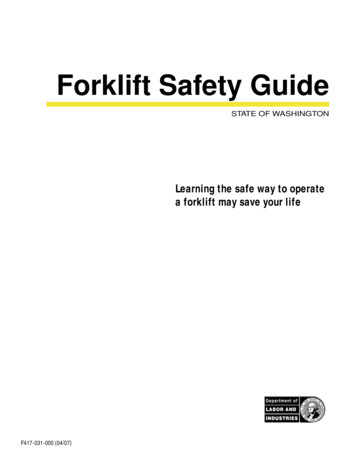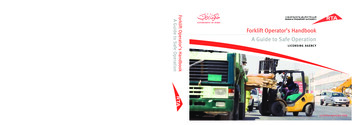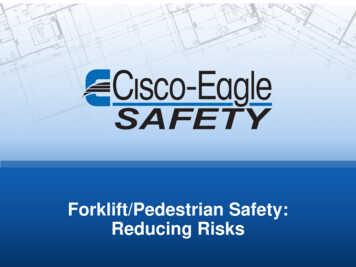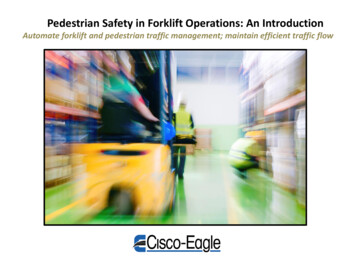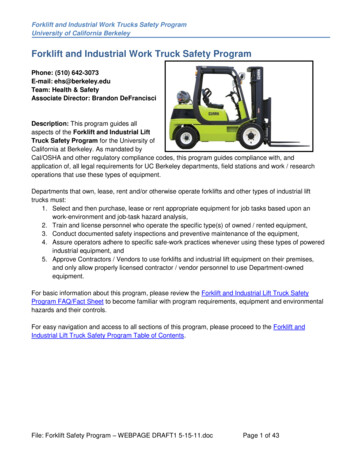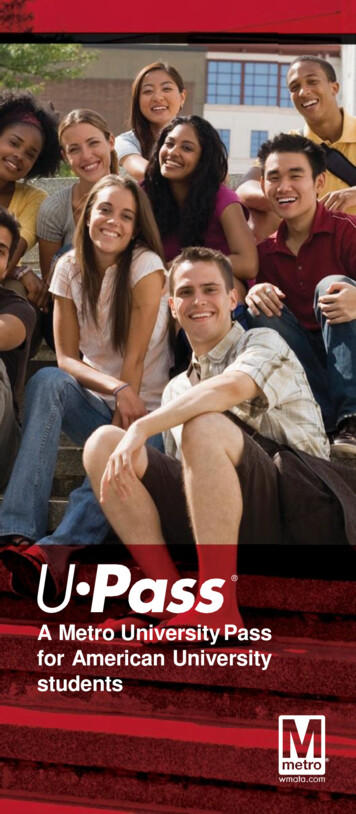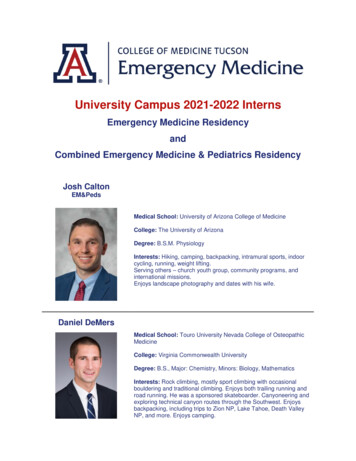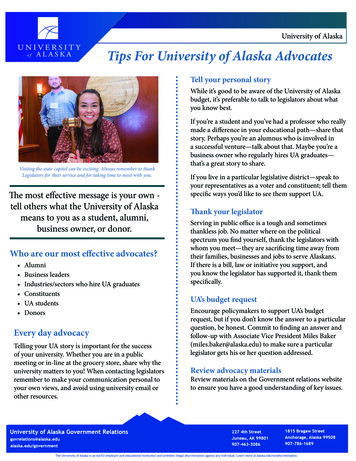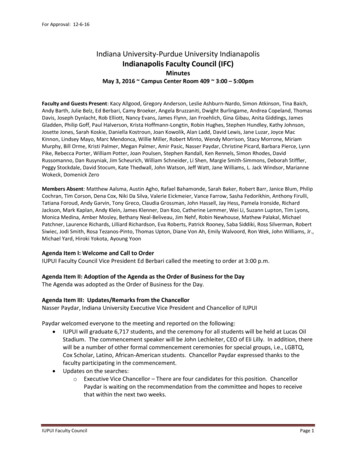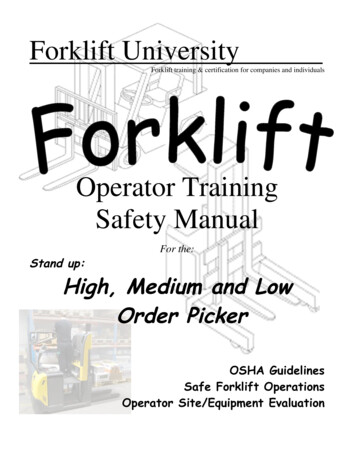
Transcription
Forklift UniversityForklift training & certification for companies and individualsOperator TrainingSafety ManualStand up:For the:High, Medium and LowOrder PickerOSHA GuidelinesSafe Forklift OperationsOperator Site/Equipment Evaluation
Forklift UniversityForklift Operator Training GuideChapter 1Introduction. . . . . . . . . . . . . . . . . . . . . . . .In this ChapterOSHA Accident SummariesOSHA Guidelines. . . . . . . . . . . . . . . . . . . . . . . .Forklifts have become commonplace in the warehouse,construction, manufacturing, and many other industries from theone man shop to the largest operation. It is all about movingmaterials, from one place to another quickly and efficiently.However, forklifts can also be a dangerous piece of equipment if itis not handled with care and respect. Because of this OSHA(Occupational Safety & Health Administration) began to requireforklift operators to be certified in 1998.The training process is outlined in the OSHA Regulations1919.178 for powered industrial trucks (forklifts). However;basically anyone that operates a forklift must complete a formaltraining course as well as receive a practical evaluation on theequipment they will be operating at the site.This manual is for Order Picker forklifts and is a supplement to astandard counterbalanced forklift training course. The associatedcourse satisfies the formal training course portion, but it is only asingle part of this requirement. Operators are encouraged to usethe information and safety training presented here as well as sitespecific training and evaluations to ensure a safe and efficientworking environment.2Copyright 2005 - 2010 Forklift Universitywww.ForkliftUniversity.com
Forklift UniversityForklift Operator Training GuideAccident SummariesForklift Tip over: While an Employee wasoperating a forklift, the forklift tippedover while the operator was making aturn at excessive speed. No seat beltwas installed and when the employee fell from the seat he was crushed bythe rollover bar.Person Falls while standing on a Pallet: The victim was found pinnedbetween the mast and the frame of the forklift. Prior to the accident theperson was raised approximately 6 feet high by the forklift operator whilethey were standing on a wooden pallet not secured to the frame of theforklift. The operator left the forklift unattended while the person wason the pallet pouring spice into a mixing tank.Fall from a Forklift Platform (Pallet): The employee was in the process ofpulling orders from the top shelf of the storage racks in the warehousearea of the grocery store. He was on the raised forks on a wooden pallet,neither he nor the pallet were secured to the forks. The forklift operatorwas moving along the aisle next to the racks when he hit something withthe tire next to the shelf and the forklift stopped suddenly. The employeeon the pallet was standing on the front edge of the pallet facing towardsthe back of the lift. The sudden stop threw him and he fell to theconcrete floor hitting his head. The pallet and most of the productsremained on the forklift, but he victim died from head injuries.3Copyright 2005 - 2010 Forklift Universitywww.ForkliftUniversity.com
Forklift UniversityForklift Operator Training GuideCrushed Skull: The victim was a 40-year-old male forklift truck operatorfor a food production and distribution company, who worked for thecompany approximately seven years. The day of the incident he wasperforming the typical task of moving product to a different row of thewarehouse using a forklift truck. During this task, the load of productbecame caught in the narrow aisles and the victim lowered the load back tothe ground. He tilted the must forward and stood between the mast andthe cage looking over the load to see the obstacle that was preventing himfrom placing the product on the shelf. His foot caught the lever, whichcontrolled the mast causing it to tilt back toward the cage. He tried to duckout of the way, but was unsuccessful; his head was crushed between themast and cage.4Copyright 2005 - 2010 Forklift Universitywww.ForkliftUniversity.com
Forklift UniversityForklift Operator Training GuideORDER PICKER ACCIDENT as told by operator: I was on an order-picker,it’s almost like a backwards forklift that you stand on, picking up a palletunderneath another shelf. The pallet I was picking up was on the floor andI was watching the blades go into the pallet because I didn’t want to pushit thru to the other side and knock everything over. When I was almostdone picking up the pallet I felt the shelf above it hit my back and Iimmediately started the order picker forward and it still went back alittle. My body was still turned a little looking at the pallet as it pushed meup against the steering wheel and across the dashboard and pushed myleft ear against the clipboard on the windshield. It seemed like it tookforever for it to start going forward and I remember thinking I was deadand who was going to take care of my kids. I closed my eyes and kind ofgrunted as it continued to push me then all of the sudden it startedforward and out. I don’t remember unclipping, but I raised the arm to getoff, I remember stumbling and seeing spots blinking all over in front of myeyes. I walked to the break table and sat down. Someone came over andasked what I was doing and I told them I was crushed. They asked me if Iwas ok and I wiggled my toes and fingers and took a deep breath and saidI was alive. Then I started to get really cold and they put me in the officeand about 10 minutes later they had someone drive me to the clinic. WhenI got to the clinic on 38th I told them I was injured at work and theyhanded me L&I papers and it seemed like I waited forever to get in to seea doctor. I can’t remember what order it was in, but I know I only had anx-ray of my chest because I saw it on the screen when I left the x-rayroom. I can remember lying there for what seemed like forever scared tomove and really cold. The doctor told me it was just muscular and that Iwas very lucky. He sent me home with Percocet, ibuprofen and musclerelaxers.5Copyright 2005 - 2010 Forklift Universitywww.ForkliftUniversity.com
Forklift UniversityForklift Operator Training GuideWork Vehicle Accident: Graham was involved in an accident at work inOctober 2008. Whilst carrying out his normal duties at work as awarehouseman, he received some instructions to go and collect one of thelow level order picker vehicles that was parked in its bay.Graham walked along the aisle to get to the order picker that requiredunloading, when suddenly one of his work colleagues began operating a lowlevel order picker vehicle on the same aisle. The same work colleague hadput some cages on the forks of his vehicle and he was trying to park thevehicle in one of the vacant bays. Unable to park in the first bay heattempted, Graham’s work colleague drove the order picker towardsanother empty bay, which was opposite where our client was now working.As the work colleague attempted to reverse the vehicle into the emptybay, he collided with Graham, trapping his left knee between the movingorder picker vehicle and the stationary vehicle that he was standing nextto, waiting to unload.As a result of this accident, Graham suffered soft tissue injury to his leftknee, which resulted in several days of swelling and several weeks ofsevere pain.6Copyright 2005 - 2010 Forklift Universitywww.ForkliftUniversity.com
Forklift UniversityForklift Operator Training GuideOSHA Requirements7Copyright 2005 - 2010 Forklift Universitywww.ForkliftUniversity.com
Forklift UniversityForklift Operator Training Guide8Copyright 2005 - 2010 Forklift Universitywww.ForkliftUniversity.com
Forklift UniversityForklift Operator Training Guide9Copyright 2005 - 2010 Forklift Universitywww.ForkliftUniversity.com
Forklift UniversityForklift Operator Training Guide10Copyright 2005 - 2010 Forklift Universitywww.ForkliftUniversity.com
Forklift UniversityForklift Operator Training Guide11Copyright 2005 - 2010 Forklift Universitywww.ForkliftUniversity.com
Forklift UniversityForklift Operator Training GuideFor the complete OSHA guidelines on forklift safety you can go towww.ForkliftUniversity.com or www.OSHA.gov.12Copyright 2005 - 2010 Forklift Universitywww.ForkliftUniversity.com
Forklift UniversityForklift Operator Training GuideChapter 2Overviews.In this ChapterCompany or Site PoliciesOverview of EquipmentOrder Picker DifferencesIntroduction to Order PickersForklift Data PlateFall Protection RequirementsMaintenance and Inspections.Forklift operations require the operator to always be aware of theirenvironment, company rules, and the mechanical state of their machines.When policies and safe procedures are not followed, or equipment is notmaintained properly and regularly, accidents happen. This guide is anoverview of safe operating procedures, rules and guidelines for forkliftoperators. In this Chapter we review your company specific policies, andsome general information about forklifts.13Copyright 2005 - 2010 Forklift Universitywww.ForkliftUniversity.com
Forklift UniversityForklift Operator Training GuideCompany or Site PoliciesMany companies have special rules in addition to the OSHA guidelines. It isimportant to follow these rules as well as the OSHA rules when operatingyour forklift. You can also find rules and instructions on operating yourforklift in the owner’s manual. Operator manuals are mandatory on eachforklift. Your first day on the job, you should clarify your company policieswith your supervisor. List site or equipment policies below:Equipment / Site Specific Information ExapmpleCapacity Information onthe Komatsu MPF 15-2ACapacity @ 24” @Lift Height ”Facility Specific Safety Rules:1.2.3.4.5.14Copyright 2005 - 2010 Forklift Universitywww.ForkliftUniversity.com
Forklift UniversityForklift Operator Training GuideOverview of EquipmentIntroduction to Order PickersThere are many different brands, makes and models of order pickerforklifts, but the most common are Crown, Komatsu, Raymond and Clark toname a few. Typically there are low and high order pickers. The difference isthat one raises the operator up while the other is more like a pallet jack anddoes not raise the operator.High Reach Order Picker ForkliftsAn order picker is a type of lift truck that features anelevating platform for the truck’s operator. Thisplatform allows the operator to be raised into the air,which facilitates less-than-unit-load picking orstocking. The operator essentially is lifted or loweredto the height of the pick or stock position with theload in order to get access to the product. The liftplatform doubles as the stocking/picking platform as well as the orderpicker’s driver cab. The platform itself is integrated with the load carryingunit (forks) and the mast. Often, the cab of an order picker features what isknown as a “dead man’s switch.” This safety switch (which can be a pedal orother special safety harness) will prevent the order picker from movingunless activated by the operator. The operation of this switch is designed sothat movement of the forklift is not possible while the operator is stockingor picking product.Low Order PickersThese units operate similar to apallet jack and do not raise theoperator in the air. Thestability characteristics are similar to standardforklift and have a stability triangle and can tip easily.15Copyright 2005 - 2010 Forklift Universitywww.ForkliftUniversity.com
Forklift UniversityForklift Operator Training GuideOther types of forklifts you may find at your facility or others include:Sit Down Rider Internal Combustion EngineThese are generally counterbalanced forklifts. The definition ofcounterbalanced is, weight added to the rear of the forklift to offset theweight of the load carried by the forklift. The type of tires can becushion/solid or pneumatic/air filled. Gasoline, LPG, or diesel engines powerthese forklifts. This type of forklift is intended for use indoors andoutdoors, on smooth floors and improved surfaces.These forklifts are front wheel drive and rear wheelsteer.Sit Down Rider ElectricThese are generally counterbalanced forklifts. Thedefinition of counterbalanced is, weight added to therear of the forklift to offset the weight of the load carried by the forklift.Because of the extreme weight of industrial batteries, the battery is placedtowards the rear of the forklift and used as the counterweight. The types oftires are typically cushion/solid, although some electric forklifts usepneumatic/air filled tires. Battery driven electric motors power theseforklifts. These types of forklifts are intended for use predominatelyindoors and have limited outdoor applications, on smooth floors and improvedsurfaces. These forklifts are front wheel drive and rear wheel steer.Motorized Hand/Rider Pallet Jacks or Walkie RidersThese pedestrian operated machines offer the option ofwalk behind or a stand up riding platform for operation.A control arm operates steering, braking, acceleration,lifting and lowering. A battery-powered electric drivenmotor operates the drive/steer tire and rotates, via thecontrol arm, allowing for a 90-degree turn in either direction. They areintended for use on smooth, flat floors.16Copyright 2005 - 2010 Forklift Universitywww.ForkliftUniversity.com
Forklift UniversityForklift Operator Training GuideWalkie StackersWalkie Stackers operate similar to motorizedpallet jacks, with steering, braking, acceleration,being on the control arm. These units have amast like a forklift with lifting heights as highas 15 feet. Lift and tilt controls are generallylocated on the body of the unit. These units canbe straddle or counterbalance design.Stand up Counter Balanced ElectricThese are generally counterbalanced forklifts. The definition ofcounterbalanced is weight added to the rear of the forklift to offset theweight of t
Forklift University Forklift training & certification for companies and individuals Operator Training Safety Manual For the: Stand up: High, Medium and Low Order
